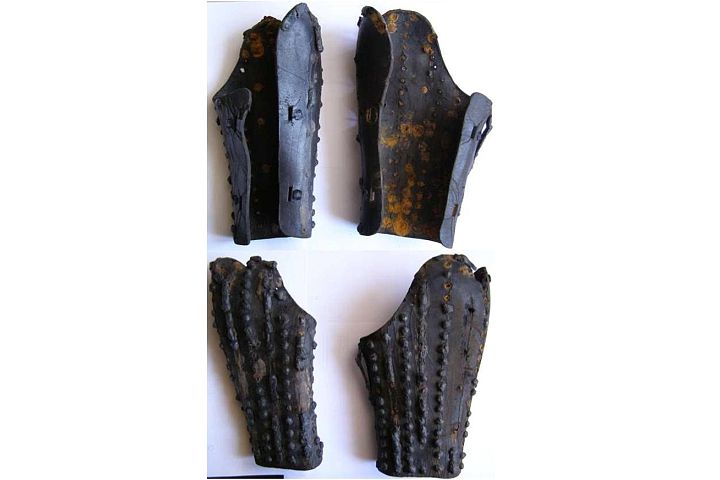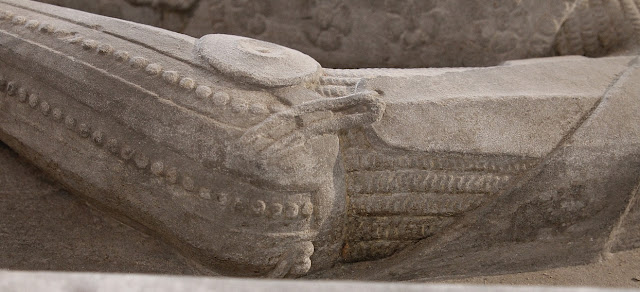I have some questions about studded armor.
1. Did studded armors exist before 1800? If so, where and when?
2. How did the studded armor compare to non-studded armor in means of protection and usefulness?
3. If it did provide added protection, then why did it?
| John Bishop wrote: |
| I have some questions about studded armor.
1. Did studded armors exist before 1800? If so, where and when? 2. How did the studded armor compare to non-studded armor in means of protection and usefulness? 3. If it did provide added protection, then why did it? |
There are two kinds of real studded armour. The first is brigandine. In brigandines where the plates are riveted to the cloth/leather, all that's visible are the rivet heads. This kind of armour was used in Europe, India, Korea, and China. The "studs" (i.e., rivet heads) don't provide any protection; the plates provide the protection. These tend to be later armours, late Medieval and later, being used into the 19th century in India and China. Some artwork showing brigandines has been incorrectly interpreted as "studded", with the writer assuming that the "studs" are the protective element. Also, these armours were often called "nail armour" or similar, at the time (especially in India and China).
The other type of studded armour is imitation brigandine. Basically, brigandine without the plates, with only the rivets. Often, this is only imitation armour, for courtiers who want a martial appearance without the weight of real armour. However, there are some Indian examples where the armour has enough layers of cloth to function as effective armour. In this case, the rivets/studs could be purely decorative, or they could help hold the layers of cloth together.
There's much more on studded armour in this thread.
To expand on what Timo said, a coat of plates, which is earlier than brigandine might also appear to be "studded" armor to the uninitiated. But like the brigandine the rivets are attached to plates (the plates being larger in the case of the coat of plates). However, my understanding is that historically a coat of plates would have often been covered by a jupon.
Splinted armour also often looks "studded." Many effigies show this, including these:
http://effigiesandbrasses.com/monuments/gunth.../original/
http://effigiesandbrasses.com/monuments/thoma...256/large/
http://effigiesandbrasses.com/monuments/gunth.../original/
http://effigiesandbrasses.com/monuments/thoma...256/large/
Effigies like those posted above are probably the origin of the studded armour idea. While they could be depicting some sort of studded armour, its more likely they're showing rivet heads of splinted armour under a layer of leather or cloth.
I'm not sure we have any evidence for armour simply relying on studs for protection.
I'm not sure we have any evidence for armour simply relying on studs for protection.
| Jojo Zerach wrote: |
| Effigies like those posted above are probably the origin of the studded armour idea. While they could be depicting some sort of studded armour, its more likely they're showing rivet heads of splinted armour under a layer of leather or cloth.
I'm not sure we have any evidence for armour simply relying on studs for protection. |
Yep, pretty much. It's a Victorian-era mistake perpetuated by Ashdown et al.
There is a possibility that this type of armour is a kind of splint with stud decoration. Although it is likely that the studs indicate a plate on the inside of the armour.
 Attachment: 33.09 KB
Attachment: 33.09 KB

 Attachment: 57.27 KB
Attachment: 57.27 KB



Page 1 of 1
You cannot post new topics in this forumYou cannot reply to topics in this forum
You cannot edit your posts in this forum
You cannot delete your posts in this forum
You cannot vote in polls in this forum
You cannot attach files in this forum
You can download files in this forum
All contents © Copyright 2003-2006 myArmoury.com — All rights reserved
Discussion forums powered by phpBB © The phpBB Group
Switch to the Full-featured Version of the forum
Discussion forums powered by phpBB © The phpBB Group
Switch to the Full-featured Version of the forum